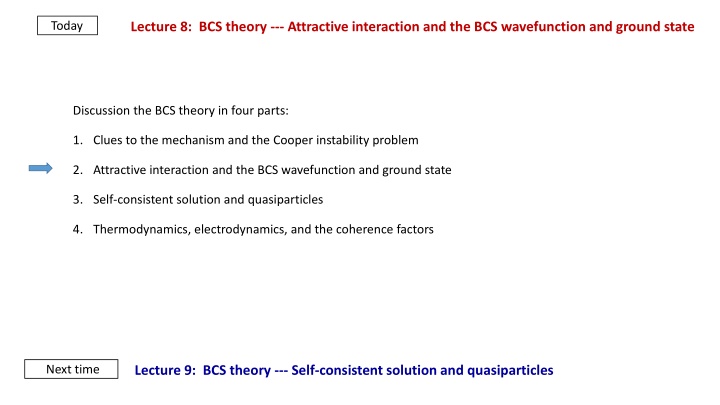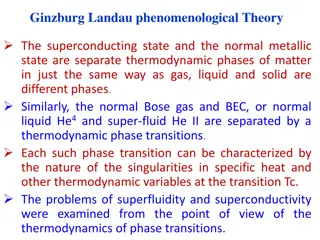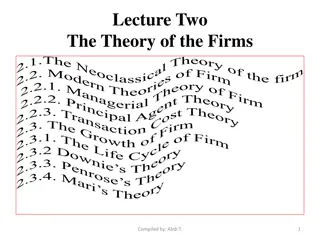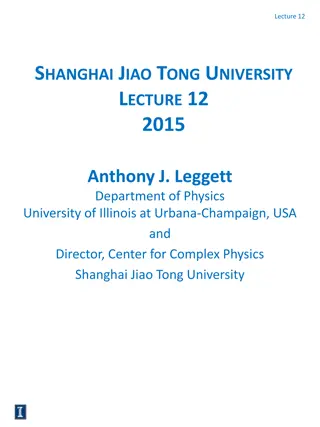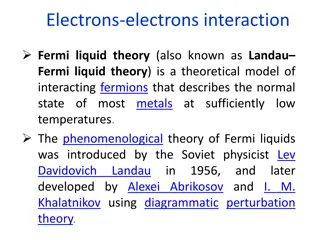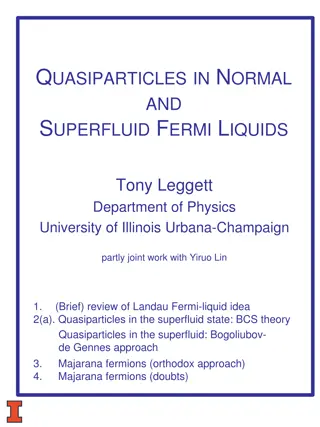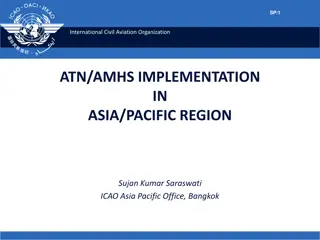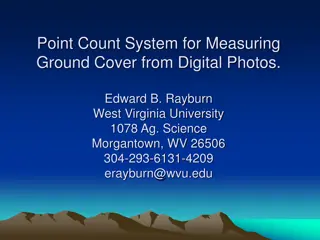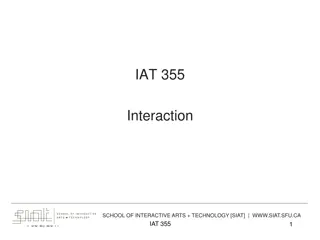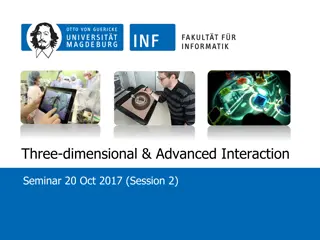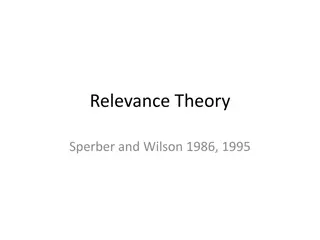BCS Theory: Attractive Interaction and Ground State Analysis
BCS theory lecture discussion on the mechanism, Cooper instability, attractive interaction, BCS wavefunction, ground state, self-consistent solution, quasiparticles, and thermodynamics. The electron-phonon interaction and its implications are also covered in detail, including the nature of the ground state, interaction with ions, and the vibrational frequency. Explore the impact of strong electron-phonon coupling and the BCS model in second quantization operators.
Download Presentation

Please find below an Image/Link to download the presentation.
The content on the website is provided AS IS for your information and personal use only. It may not be sold, licensed, or shared on other websites without obtaining consent from the author.If you encounter any issues during the download, it is possible that the publisher has removed the file from their server.
You are allowed to download the files provided on this website for personal or commercial use, subject to the condition that they are used lawfully. All files are the property of their respective owners.
The content on the website is provided AS IS for your information and personal use only. It may not be sold, licensed, or shared on other websites without obtaining consent from the author.
E N D
Presentation Transcript
Today Lecture 8: BCS theory --- Attractive interaction and the BCS wavefunction and ground state Discussion the BCS theory in four parts: 1. Clues to the mechanism and the Cooper instability problem 2. Attractive interaction and the BCS wavefunction and ground state 3. Self-consistent solution and quasiparticles 4. Thermodynamics, electrodynamics, and the coherence factors Next time Lecture 9: BCS theory --- Self-consistent solution and quasiparticles
Last time: Cooper Instability c Attractive for ??< ?? E 2 ? 0 ? k F (? 0 ? 1) ??= 2 ?? ? k weak coupling Need filled FS to get lots of available states for scattering Today: (1) Details of the attractive interaction Ground state band of scattering states of energy width ~ ??around Fermi surface (2) Nature of SC ground state (if N unstable) (3) ??? wavefunction
Electron Phonon Interaction Fr lich (1950) Pines Bardeen 1950 s Electrons repulsive (long range) k ? , ? ?( ?) ?, ? ??,? = 'k ?2 ? ??? ? ? ?? ? 2e r ( ) = V r 4??2 ?2 bare Coulomb repulsion ? = ? ? for ??= > 0 In general, define (?,?) dielectric function Add in screening by electrons and ions: 4??2 ?2+ ??2 ?2 ? ? ??? 4??2 ?2 > 0 ??= 1st electrons: 1 ? ? = ??= ?(?,?) ??2 ?2 Interaction is cutoff at short q (long ) For electron screening, ? ? 0,? 0 = 1 + 1 ?? (? = = screening length) Static screening, long wavelength (Thomas-Fermi screening) Still repulsive no ??
2nd ions: Static ions --- no response to an electron + + Dynamic ions --- ions respond slowly but if driven at phonon frequency there is a resonance e- Effective residual positive charge attracts the electron + + + direct repulsive force retarded attractive force Dynamical phonon-mediated electron-phonon interaction --- not a static e-e attraction 4??2 ?2+??2 (1 + ?? ?2 ??2) Both electrons and ions: ??= ?2 ??2 ?? ? ?,0 ?? ?,0 balance between Coulomb repulsion and electron-phonon coupling attractive repulsive V q q c q ??= resonance frequency BCS attractive potential (cutoff not critical)
? ? ?? ~ (2) What is ?? ? vibrational or phonon equency ? ? ion mass Interaction should scale as M 1/2 isotope effect If electron-phonon coupling is strong (bad conductor at room T), ?? large .. good for SC There are more accurate forms, but the model is not very sensitive except for getting numerical values for ?? band structure These can include: material parameter (e.g. elastic constants, phonon structure ) finite ion cores Biggest changes at low ? more attractive ! BCS model --- expressed in terms of 2nd quantization operators: + creation creates an electron at momentum (wavevector) ? and spin ? ??? annihilates an electron at momentum (wavevector)? and spin ? ??? annihilation + +,?? ? + +??? ??? = ????? ? + ??? Fermions : anti-communication = ??? ??? ?+?+= ?,? = 0 +??? ??,?= ??? Number operator
BCS Theory (1957) Solved the problem of superconductivity --- simplified the model enough to be soluble BUT kept the essential physics
BCS model Assume ground state will consist of paired states (?, ?) with singlet spin-pairing --- most general form: state to fill E k + w M F c +?? ? ? ? ?= ?? 0 ? 2? ? ????? 0 0 Fill states ?, ? until N electrons. 2)! 10? 10(1022) ways, which is also the number of terms and coefficients ?! 2!(? Can do that ? ? *BCS used a Hartree self-consistent field or mean field approximation: this assumes that each electron-pair state depends on an average over other states Hartree approximation is critical for reducing many-body electron problems to single electron states Consequence electron-pair state occupancy depends on averaged quantities, which relaxes the constraints on the number and occupancy of all states filled at any instant ( grand canonical ensemble )
BCS wavefunction ( ) + + = + 0 u k k v c c Generate BCS ground state by adding pairs to the vacuum state G k k 1,... k k m 1 2 1 2 +?? (1 ?) ? ?? BCS notation: Bogoluibov notation is generally used + + c c ?? c c ?? Bogoluibov notation: k k k k ??,?? are complex (same relative phase for all ?) important 2+ ?? 2= 1 ? ? ?? 2 = probability that the pair state (?, ?) is occupied ?? 2 = probability that the pair state (?, ?) is empty ?? M = | consists of terms with different numbers of electrons: G N N = 0 N ??1??2 ??? (0) 0 0 pairs +? ? + (M) ??1??2 ??? ?? 0 M pairs ? ? Filled band (all states)
Intermediate size states look like ?? = states above Strange wavefunction since N is variable but these creates no problems because : (1) ? large so fluctuations in N are small + + 0 u v c c /2 N k k k k /2 /2 /2 M N empty N N (2) Can project out a state (with N) if needed occupied occupied A(k s) +?? + ?? +?? ? 2 = ???= ??? = 2 ?? (mean) ? ? ??2???= (? ?)2= ?2 ?2 ??2??2= 4 ??21 ??2 = 4 (variance) ? ? ??2??? State with few or many particles are unlikely --- deviations small 2 kv 2 ku 2 N 1 2 ~ ? 1 2 ~ 1010 ?????= (? ?)2 k 0 N N
Projection (via phase) phase fixed ( )0 = + + = + i u v e c c n n G k k k k k k phase factor N i + + = 0 u v e c c 2 k k k k k k k k empty occupied occupied ? electrons 2? ? ?(? 2)? ?= ? ?? ? Projects out 0 ?? is an eigenstate of ?, N undetermined ? ? 1 Uncertainly relation: ?? is an eigenstate of N, ? undetermined
Hamiltonians Besides choosing a specific form for the wavefunction, BCS also simplified the Hamiltonian: 1 2 k k c c + + + = + H V c c c c General H (interacting electrons): ' ' ' ' ' k kk k k , ' , ' , ' k k k k ' ' = ? + ? k Could allow spin flip scattering ' ' q = ? + ? 1 2 k k c c + + + = + H V c c c c BCS pairing ( reduced ) H: BCS k k k k , k k k Vq Same as Cooper in 2nd quantization form k q Keep terms allowing interactions between paired electrons only. Terms left out are same in normal metal. ? + ? = In further extensions, treat left out terms in perturbation theory electrodynamic and other properties
( ) + + = + 0 u k k v c c BCS ground state: G k k 1,... k k m 2+ ?? 2= 1 Eigenstate of ? so N is indeterminate ?? , , k k k k empty full 1 2 k k c c + + + = + H V c c c c BCS (reduced) H: R k k k k , k k We will solve this in two ways: (1) Variational calculation ??,??, in the ground state (2) Diagonalize H excitation spectrum
Variational Calculation N 0 Problem: ? can have any number of pairs so we would expect to get minimum energy for Solution: constraint onNby use of a Lagrange multiplier measure energies with respect to so ?? ?? ???? ???? ?? k k c c + + + = + E V c c c c BCS G k k G k k k k = = j k i k For a particular k and : ( ) ( )( ( ) ) + + + + = + + * j * j 0 0 E u v c c c c c c u v c c ??? = initial BCS j j k k i i i i j i ?? = final ? i = j = k k ( )( = ( ) ) 2 * * k 2 + E v V u v u v q BCS k k k k k k
Solution: ku kv = Assume that the and real sin u + = 2 k 2 k 1 u v k k = cos v k k ( )( ) = = 2 k 2 k 2 2 cos2 cos sin u v = + 2 2 cos sin cos sin cos E V k BCS k k k k k k k = = sin2 2 2cos sin u v k k k k k 1 4 ( ) = 1 cos2 + + sin2 sin2 V k k k k k d = = 0 0 E minimize each term BCS d k + = 2 sin2 cos2 sin2 0 V k k k k = sin2 V k tan2 k 2 k
EQUATIONS SOLUTION = = = 2 k 2 k 2 2 k cos2 cos sin u v k E k = + 2 k 2 k E where k = = = k sin2 2 2cos sin u v k k k k k E 1 2 1 2 k = = = sin2 V V u v V = and sin2 V k k k k E k = k k tan2 k k 2 k 11 2 11 2 = + 2 k u k = 2 k Then: v k E E k k E k 2 kv 2 ku 1 K K
Gap equation 1 2 = Iterative equation k V k E E F if otherwise V 0 BCS form of the potential: (similar to Cooper potential but spread across EF) k c k V = c 1 2 (NB: isotropic interaction leads to isotropic gap)X = = same for all states V k E ring ( ) ( ) ( ) 0 2 N E N V 1 E V 1 V 1 w + w w + w ( ) 0 ( ) 0 = = = c c 1 = d = c d d 1 N V sinh N V c ( ) 2 ( ) 1 2 E w w 0 + 2 k 2 2 c c 0 w = 1 c BCS: ( ) 0 N V 1 2 w e BCS sinh c ( ) 0 Weak coupling ( ) 0 N V N V 1: 2 1 ( ) 0 ( ) 0 N V N V = 2 E w e e 2 w Cooper = Cooper: E c B c B 2 ( ) 0 N V ?? ? 1 e
Condensation Energy spin = ( ) 2 E Normal State: N k k k F = + E KE PE SC State: S = = 2 k PE V u u v v 2 KE v k k k k k k )( ) ( = + 2 2 k 2 2 1 k k v u = u v V u v k k k k k k k k F F k ( ) = + 2 k 2 2 2 v ( ) = u v k k k k K k k k k F F k ( ) ( ) 2 k 2 k = v u since k k = V u v k k V k k u v k 2 k = + 2 E 2 k N E = k k k F V 2 2 1 2 1 2 k ( ) 0 ( ) 0 = + = + 2 1 N E N V E 0 N N V V 1 effective pairs = pair condensation amplitude weak coupling
Condensation energy 1 2 ( ) 0 = = 2 E E E N C N S and KE PE Delicate balance between PE KE E C 100 500 1 10 hw k K Typically, c B D D T B c k T K c ( ) 0 0.1 0.2 1 N V n D T c Cooper idea right excite above to get paring interaction until no benefit F E BCS ground state
